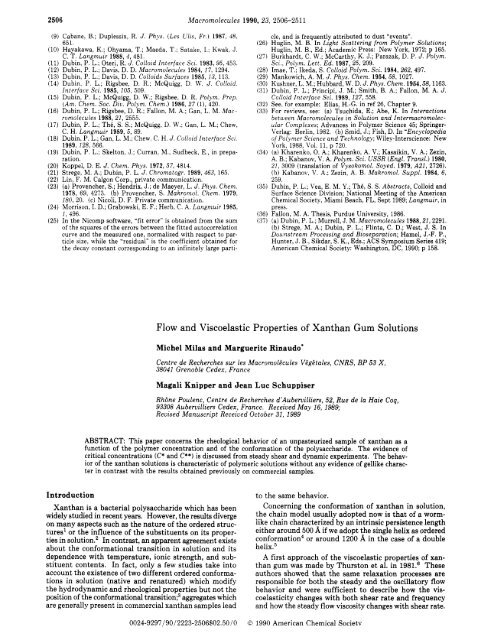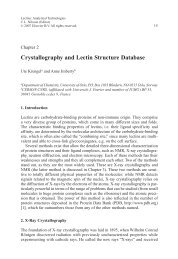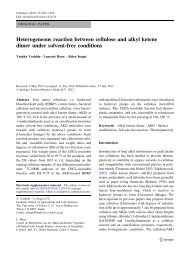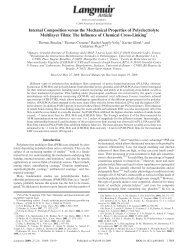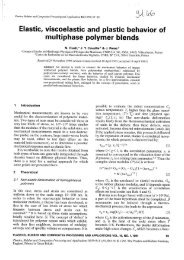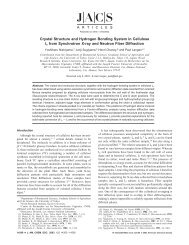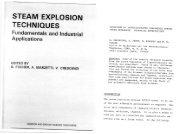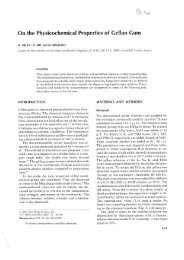Flow and Viscoelastic Properties of Xanthan Gum Solutions
Flow and Viscoelastic Properties of Xanthan Gum Solutions
Flow and Viscoelastic Properties of Xanthan Gum Solutions
Create successful ePaper yourself
Turn your PDF publications into a flip-book with our unique Google optimized e-Paper software.
2506 Macromolecules 1990, 23, 2506-2511<br />
(9) Cabane, B.; Duplessix, R. J. Phys. (Les lilis, Fr.) 1987, 48,<br />
651.<br />
(10) Havakawa. K.: Ohvama. T.: Maeda. T.: Satake. I.: Kwak. J.<br />
C. T. Langmuir 168, 4, 481.<br />
(11) Dubin, P. L.; Oteri, R. J. Colloid Interface SCL. 1983,95,453.<br />
(12) Dubin. P. L.; Davis, D. D. Macromolec'ules 1984, 17, 1294.<br />
(13) Dubin, P. L.; Davis, D. D. Colloids Surfaces 1985, 13, 113.<br />
(14) Dubin. P. L.; Rigsbee, D. R.; McQuigg, D. W. J. Colloid.<br />
Interface Sci. 1985, 105, 509.<br />
(15) Dubin, P. L.; McQuigg, D. W.; Rigsbee, D. R. Polym. Prep.<br />
(Am. Chem. SOC. Diu. Polym. Chem.) 1986, 27 (l), 420.<br />
(16) Dubin. P. L.: Rigsbee. D. R.: Fallon. M. A,: Gan. L. M. Macromolecules<br />
19@, 21,'2555.<br />
(17) Dubin, P. L.; ThB, S. S.; McQuigg, D. W.; Gan, L. M.; Chew,<br />
C. H. Langmuir 1989,5,89.<br />
118) Dubin. P. L.: Gan. L. M.: Chew. C. H. J. Colloid Interface SCL.<br />
1989, 128, 566.<br />
(19) Dubin, P. L.; Skelton, J.; Curran, M., Sudbeck. E., in preparation.<br />
(20) Koppel, D. E. J. Chem. Phys. 1972,57, 4814.<br />
(21) Strege, M. A.; Dubin, P. L. J. Chromatogr. 1989, 463, 165.<br />
(22) Lin, F. M. Calgon Corp., private communication.<br />
(23) (a) Provencher, S.; Hendrix, J.; de Maeyer, L. J. Phys. Chem.<br />
1978, 69, 4273. (b) Provencher, S. Makromol. Chem. 1979,<br />
180, 20. (c) Nicoli, D. F. Private communication.<br />
(24) Morrison. I. D.; Grabowski, E. F.; Herb, C. A. Langmuir 1985,<br />
I, 496.<br />
(25) In the Nicomp s<strong>of</strong>tware, "fit error" is obtained from the sum<br />
<strong>of</strong> the squares <strong>of</strong> the errors between the fitted autocorrelation<br />
curve <strong>and</strong> the measured one, normalized with respect to particle<br />
size, while the "residual" is the coefficient obtained for<br />
the decay constant corresponding to an infinitely large parti-<br />
Introduction<br />
cle, <strong>and</strong> is frequently attributed to dust "events".<br />
(26) Huglin, M. B. In Light Scattering from Polymer <strong>Solutions</strong>;<br />
Huglin, M. B., Ed.; Academic Press: New York, 1972; p 165.<br />
(27) Burkhardt, C. W.; McCarthy, K. J.; Parazak, D. P, J. Polym.<br />
Sci., Polym. Lett. Ed. 1987,25, 209.<br />
(28) Imae, T.; Ikeda, S. Colloid Polym. Sei. 1984, 262, 497.<br />
(29) Mankowich, A. M. J. Phys. Chem. 1954,58, 1027.<br />
(30) Kushner, L. M.; Hubbard, W. D. J. Phys. Chem. 1954,58,1163.<br />
(31) Dubin, P. L.; Principi, J. M.; Smith, B. A,; Fallon, M. A. J.<br />
Colloid Interface Sci. 1989, 227, 558.<br />
(32) See. for example: Elias, H.-G. in ref 26, Chapter 9.<br />
(331 For reviews, see: (a) Tsuchida, E.; Abe, K. In Interactions<br />
betlceen Macromolecules in Solution <strong>and</strong> Intermacromolec-<br />
ular Complexes; Advances in Polymer Science 45; Springer-<br />
Verlag: Berlin, 1982. (b) Smid, J.; Fish, D. In "Encyclopedia<br />
<strong>of</strong> Polvmer Science <strong>and</strong> Technolom: Wilev-Interscience: New<br />
Macromolecules, Vol. 23, No. 9, 1990 <strong>Flow</strong> <strong>and</strong> <strong>Viscoelastic</strong> <strong>Properties</strong> <strong>of</strong> <strong>Xanthan</strong> 2507<br />
Later, from a wide range <strong>of</strong> rheological experiments, Ross-<br />
Murphy et al.'l8 found that solution viscoelasticity was<br />
drastically modified by changing the counterion <strong>of</strong> the<br />
polyelectrolyte <strong>and</strong> by treatment with urea, although in<br />
all cases, the local ordered structure was unaffected. They<br />
conclude that, in aqueous solution, xanthan may be<br />
regarded as a highly extended wormlike chain interacting<br />
by noncovalent association to develop a weak-gel network,<br />
which is readily reversible under shear. For example,<br />
the so-called Cox-Merz rule is no more obeyed even<br />
in semidilute solutions <strong>and</strong> at lower frequencies <strong>and</strong> shear<br />
rates. A similar behavior was found by Cuvelier <strong>and</strong><br />
Launay? These authors deduced from flow <strong>and</strong> <strong>Viscoelastic</strong><br />
properties different concentration regimes in xanthan<br />
gum solution in which different master curves are<br />
obtained due to a change in the density <strong>of</strong> junction zones<br />
<strong>of</strong> the elastic network formed by side by side associations.<br />
The influence <strong>of</strong> salt, temperature, <strong>and</strong> strain effects<br />
on the structure <strong>of</strong> xanthan solution from xanthan dried<br />
powder <strong>and</strong> a pasteurized fermentation broth has been<br />
studied by Rochefort <strong>and</strong> Middlemanlo using oscillatory<br />
<strong>and</strong> steady shear experiments. Their conclusions are very<br />
similar to the previous ones. Nevertheless, a master curve<br />
<strong>of</strong> dynamic properties covering 6 decades <strong>of</strong> frequency<br />
has been obtained in highly saline solution <strong>and</strong> the<br />
frequency/temperature superposition allows characterization<br />
<strong>of</strong> the conformational transition induced by temperature<br />
change. More recently, steady <strong>and</strong> dynamic shear<br />
properties <strong>of</strong> aqueous polymer solutions, including xanthan,<br />
have been published." These studies have been<br />
carried out for xanthan concentration lower than 1 g/L<br />
<strong>and</strong> for frequencies lower than 1 rad/s. In these conditions,<br />
in absence <strong>of</strong> salt, they found that measurements<br />
follow the Cox-Merz rule in low shear rate <strong>and</strong> frequency<br />
regions <strong>and</strong> that the dynamic results agree qualitatively<br />
with the trend predicted by the Zimm molecular<br />
model. A master curve is obtained by means <strong>of</strong> the<br />
shift factor MICRT as suggested by Ferry.12 Nevertheless,<br />
the rheological properties <strong>of</strong> xanthan depend not<br />
only on the nature <strong>of</strong> the counterion <strong>and</strong> salt contents<br />
but also on postfermentation treatments like pasteurization<br />
<strong>and</strong> drying which form in xanthan commercial samples<br />
large <strong>and</strong> irreversible aggregates.13 From these Samples,<br />
gellike behavior is well demonstrated from the previous<br />
studies,+l0 <strong>and</strong> it is clear that the structure <strong>of</strong> these<br />
solutions cannot be described by a classical polymer entanglement<br />
concept.<br />
In this paper, a xanthan from an unpasteurized broth<br />
was used, taking care to avoid aggregation <strong>and</strong> to preserve<br />
the native conformation during purifi~ation.~ Using<br />
this well-characterized xanthan, steady shear <strong>and</strong> dynamic<br />
experiments were performed in the native <strong>and</strong> renatured<br />
conformations in dilute <strong>and</strong> semidilute regimes in<br />
the range <strong>of</strong> polymer concentration up to 5 g/L (i.e, C[a]<br />
< 65).<br />
Experimental<br />
Material. An unpasteurized broth from RhSne Poulenc (Aub-<br />
ervilliers, France) was diluted in 0.01 M NaCl solution to an<br />
estimated concentration <strong>of</strong> about 1 g/L. It was filtered through<br />
8-, 3-, 1.2-, <strong>and</strong> 0.8-pm Millipore filters successively <strong>and</strong> centrif-<br />
ugated for 2 h at 20000g. Afterward, NaCl(60 g/L) was added.<br />
The xanthan was precipitated by addition <strong>of</strong> ethanol to a con-<br />
centration <strong>of</strong> 50% (v/v). The precipitate was then washed suc-<br />
cessively with ethanol/water mixtures from 70% (v/v) to 100%.<br />
The xanthan powder was dried at 25 "C under vacuum for 2<br />
days. Afterward it was stored in ambient conditions until it<br />
reached equilibrium; its degree <strong>of</strong> hydration measured by ther-<br />
mogravimetry with a Setaram balance (Model G70) was then<br />
12%. This method for the recovery <strong>of</strong> xanthan from the broth<br />
Table I<br />
Characteristics <strong>of</strong> <strong>Xanthan</strong> in Dilute <strong>Solutions</strong>*<br />
conformation<br />
Mw<br />
A mL<br />
g-$mol<br />
[dT<br />
m /g k'<br />
c*,<br />
g/L<br />
c**,<br />
g/L<br />
native<br />
renatured<br />
5.25 X 10' 0.6 X lo-'<br />
5.25 X lo6 0.7 X<br />
10 300<br />
13 200<br />
0.45 0.126 0.78<br />
0.46 0.100 0.60<br />
a Note: C* <strong>and</strong> C** are obtained from Figure 2.<br />
preserves the native ordered structure (N) <strong>and</strong> gives the sodium<br />
salt with the minimum <strong>of</strong> aggregation. The solutions were pre-<br />
pared by dissolving the required amount <strong>of</strong> purified xanthan<br />
in 0.01 M NaCl solution. Half <strong>of</strong> the volume <strong>of</strong> these solutions<br />
was heated at 80 "C (1 min) <strong>and</strong> cooled to 20 "C. After this<br />
cycle, the xanthan is in its renatured conformation (R).' Then,<br />
9% (v/v) <strong>of</strong> 1 M NaCl solution was added into the heated <strong>and</strong><br />
nonheated solutions in order to reach a final NaCl concentra-<br />
tion equal to 0.1 M. The lowest xanthan concentrations were<br />
obtained by dilution <strong>of</strong> a more concentrated polymeric solution<br />
with 0.1 M NaCl. Nevertheless, it was checked that the results<br />
were independent <strong>of</strong> the solution preparation technique (direct<br />
dissolution or dilution <strong>of</strong> a more concentrated solution).<br />
Techniques. The degrees <strong>of</strong> pyruvate substitution <strong>and</strong> acety-<br />
lation were measured by 'H NMR. Dried xanthan was dis-<br />
solved in 5 X lo-' M sodium acetate solution (in D,O) at a<br />
polymer concentration <strong>of</strong> about 5 g/L. Sodium acetate (5 X<br />
M) was used as an internal st<strong>and</strong>ard. The spectra were<br />
obtained with a Bruker WP 100 spectrometer at 85 "C. The<br />
OH signals were suppressed by irradiation. A total <strong>of</strong> 200 scans<br />
were accumulated with a repetition time <strong>of</strong> 7 s <strong>and</strong> a sweep<br />
width <strong>of</strong> 1125 Hz. The acetate <strong>and</strong> pyruvate yields were expressed<br />
as an average number per side chain.<br />
Intensities <strong>of</strong> light scattered from the xanthan solutions (poly-<br />
mer concentrations usually lower than C* varied from 0.02 to<br />
0.15 g/L in 0.1 M NaC1) were measured at an angle <strong>of</strong> 6O with<br />
a low-angle laser light scattering apparatus (Chromatix KMX<br />
6) at 25 "C; clarification <strong>of</strong> xanthan solutions was achieved by<br />
filtration throguh 0.22-pm Millipore filters. The value <strong>of</strong> dn/dc<br />
was taken to be 0.155 mL/g.' The main characteristics <strong>of</strong> the<br />
polymer used are the following: M, = 5.25 X 10'; pyruvate <strong>and</strong><br />
acetate contents equal 0.25 <strong>and</strong> 0.50, respectively. <strong>Flow</strong> curves<br />
were obtained with two viscometers: the Contraves low-shear<br />
LS30 (y from 0.017 to 128 8-l) <strong>and</strong> the Carrimed CS 50 (y from<br />
0.02 to 2500 8-l) using different coaxial cylinder <strong>and</strong> cone-plate<br />
systems.<br />
Dynamic measurements were performed with the Rheomet-<br />
rics fluid spectrometer (RFS) (rate from lo-* to 10, rad/s <strong>and</strong><br />
strain from 1 to 50%) using a coaxial cylinder (R, = 16 mm, R,<br />
= 17 mm, <strong>and</strong> h = 32 mm). The torque has to be greater than<br />
5 X lo-' N-m.<br />
All the rheological experiments were performed in 0.1 M NaCl<br />
<strong>and</strong> at constant temperature (25 "C).<br />
Results <strong>and</strong> Discussion<br />
1. Characterization <strong>of</strong> <strong>Xanthan</strong> <strong>Solutions</strong> in the<br />
Newtonian Regime. The weight-average molecular<br />
weight, Mw, the intrinsic viscosities, [a], determined in<br />
the Newtonian regime, the second virial coefficients, A,,<br />
<strong>and</strong> the Huggins constant, k', are given in Table I for<br />
xanthan in the native <strong>and</strong> renatured conformations. The<br />
polydispersity was determined by steric exclusion chromatography<br />
<strong>and</strong> found to be 1.5.14<br />
Viscosities in the Newtonian plateau <strong>and</strong> their dependence<br />
on shear rate were determined on the two conformations<br />
in the range <strong>of</strong> polymer concentration from 0.0125<br />
to 5 g/L; a few experimental results obtained for the relative<br />
viscosity are given in Figure 1.<br />
The values <strong>of</strong> the specific viscosities in the Newtonian<br />
regime (reached only for xanthan concentration lower than<br />
2.5 g/L) as a function <strong>of</strong> the overlap parameter C[v] in<br />
a logarithmic plot are given in Figure 2. A unique curve
2508 Milas et al.<br />
F<br />
-<br />
L<br />
0<br />
F<br />
I<br />
5<br />
10 1<br />
5<br />
10<br />
4<br />
10<br />
10<br />
2<br />
10<br />
'<br />
.<br />
'<br />
:<br />
'<br />
0.5%<br />
0.2%<br />
0.15%<br />
0.10%<br />
0.075%<br />
I<br />
+<br />
XI<br />
X<br />
x x<br />
x4<br />
Xanthsn<br />
State N<br />
X ' I<br />
<strong>Xanthan</strong> gum<br />
State R (b)<br />
n 1 X I<br />
X' n,<br />
1<br />
-3<br />
10<br />
'.2<br />
10 '- 1<br />
10<br />
IO<br />
10<br />
11<br />
10<br />
I<br />
12<br />
10<br />
10 I 11,111 I I11111 I , 11111, I I111111 I 1111111 1 I<br />
frequency o or shsar rate Y (s-1)<br />
Figure 1. Steady shear viscosity, 9 (x), <strong>and</strong> modulus <strong>of</strong> the<br />
complex viscosity, T* (w), as a function <strong>of</strong> y <strong>and</strong> w for (a) the<br />
native state conformation (N) <strong>and</strong> (b) the renatured state (R)<br />
(T, 25 "C; solvent, NaCl 0.1 M).<br />
is obtained corresponding to the development:<br />
lisp = C[ql + k'(c[?1)2 + ... + B(C[71)"<br />
When C[q] increases, the transition between dilute <strong>and</strong><br />
semidilute regimes is characterized by a critical concen-<br />
I<br />
I<br />
I<br />
I<br />
n<br />
5<br />
10<br />
4<br />
10<br />
3<br />
10<br />
F 2<br />
z. 10 =<br />
0<br />
.f 1<br />
70<br />
0<br />
.- - .-<br />
u<br />
0 0<br />
3 10<br />
1<br />
10<br />
Macromolecules, Vol. 23, No. 9, 1990<br />
1 103<br />
-1<br />
I I I I 11~1,~*1<br />
I I I I I I 1111, I , 1111 10 10 10 10<br />
c rrl 3<br />
2<br />
c Irl I + K' (C [tl I 1<br />
Figure 2. Dependence <strong>of</strong> the specific viscosity, qS , as a function<br />
<strong>of</strong> (a) the overlap parameter, C[v], <strong>and</strong> (b) tie function<br />
C[q] + k'(C[~l)~ for the state N (W <strong>and</strong> 0, respectively) <strong>and</strong><br />
state R (* <strong>and</strong> +). The critical concentrations (C* <strong>and</strong> C**)<br />
<strong>and</strong> the values <strong>of</strong> the slopes (s) are indicated. (Same conditions<br />
as Figure 1.)<br />
tration C*; this transition is well characterized by the<br />
departure <strong>of</strong> the curve from the slope 1 when the qsp values<br />
are plotted against C[v] + k'(C[q])', characterizing<br />
the dilute regime. The values obtained for C* are given<br />
in Table I; they are in the range <strong>of</strong> C*[q] - 1 as usually<br />
found.15<br />
For higher values <strong>of</strong> C[q] (i.e., C[q] > 8), the dependence<br />
<strong>of</strong> v,, with C[q] becomes linear with a slope equal<br />
to 3.7 f 0.3. Consequently, in the higher polymer concentration<br />
range, the dependence becomes<br />
C3.7[q]3.7 or C3.7M4<br />
'7sp -<br />
considering the Mark-Houwink parameter a = 1.1 for<br />
xanthan in 0.1 M NaC1.14 The experimental values<br />
obtained for C**, such as C**[v] = 8, are given in Table<br />
I.<br />
These results are in good agreement with works on many<br />
synthetic polymers <strong>and</strong> polysaccharides. The experimental<br />
values <strong>of</strong> the critical concentrations C* <strong>and</strong> C** fit<br />
quite well with theoretical predictions based on spacefilling<br />
considerations: 0.7 < C*[q] < 1.5 <strong>and</strong> C**[qle =<br />
6.14.16 The difference between this last value <strong>and</strong> our<br />
result, C**[q] - 8, can be attributed to chain contraction<br />
occurring when polymer concentration increases up<br />
to the 8 state in the concentrated domain; this effect is<br />
not considered in the plot as a function <strong>of</strong> C[v] in which<br />
['7] is taken as the experimental value for infinite dilution.<br />
So, C[q] - 8 characterizes the threshold <strong>of</strong> the linear<br />
dependence <strong>of</strong> log qsp with log C[q] but also the value<br />
after which a divergence to the Martin equation16 qo -<br />
pa = q,C[q] exp(k"C[q]) is observed. This limit C[q] -<br />
8 introduces a transition from the semidilute regime to<br />
a concentrated regime characterized by a uniform segment<br />
density in solution16 where free-draining behavior<br />
becomes predominant. In this last domain, the behavior<br />
looks like that <strong>of</strong> a melt. Then, for linear polymers<br />
interacting by purely topological entanglements, de Gennes17,18<br />
has predicted that q - M3C4 for polymer solu-<br />
3
Macromolecules, Vol. 23, No. 9, 1990 <strong>Flow</strong> <strong>and</strong> <strong>Viscoelastic</strong> <strong>Properties</strong> <strong>of</strong> <strong>Xanthan</strong> 2509<br />
1<br />
10 I<br />
\ 6-4<br />
\<br />
&/<br />
1<br />
: C* I c**<br />
10-4 lo" ' ' ' ""' 1' O0<br />
r' O1<br />
CM<br />
Figure 3. Reduced value <strong>of</strong> the shear rate corresponding. to<br />
the transition from Newtonian to pseudoplastic behavior (yr/<br />
yro) <strong>and</strong> reduced relaxation time, T ~ ~ / estimated T ~ , in the Rouse<br />
model as a function <strong>of</strong> the overlap parameter for the state N<br />
(H <strong>and</strong> 0, respectively) <strong>and</strong> for the state R (* <strong>and</strong> +). awp is<br />
also represented for the native state N (a) <strong>and</strong> the renatured<br />
state R (A) (a frequency shift factor).<br />
tion in absence <strong>of</strong> hydrodynamic interactions <strong>and</strong> in 8<br />
conditions, which agrees well with that observed experimentally.<br />
Previously, C3.3 dependence has been reported<br />
above C[q] - 4 for r<strong>and</strong>om coil polysaccharide solution~.'~<br />
Nevertheless, higher exponents, characteristic <strong>of</strong><br />
more specific polymer-polymer interactions, have been<br />
obtained on xanthang or guar galactomannan.20 The<br />
dependence on M cannot be discussed as we have used<br />
only one xanthan molecular weight. Then, our results<br />
show that, in the range <strong>of</strong> concentration investigated here<br />
(lower than 2.5 g/L), no specific interactions exist between<br />
xanthan chain segments in addition to normal topological<br />
entanglements, similar to other polysaccharide^^^ but<br />
in contrast to previous data published on commercial pasteurized<br />
samples <strong>of</strong> xanthan6-10<br />
2. <strong>Flow</strong> Curves. (a) Onset <strong>of</strong> the Shear Rate-<br />
Viscosity Dependence. Considering the curves given<br />
in Figure 1, it is shown that the onset <strong>of</strong> non-Newtonian<br />
behavior shifts to higher shear rates with decreasing concentration.<br />
The transition from Newtonian to viscoelastic<br />
behavior.is characterized by a critical value <strong>of</strong> the<br />
shear rate, yr, usually considered as the longest relaxation<br />
time <strong>of</strong> the Rouse spectrum for the polymeric solution.<br />
For low polymer concentrations, a limiting value<br />
is reached independent <strong>of</strong> the concentration (yro). The<br />
rro value is equal to about 11 f 2 s-'. Due to imprecision<br />
on its determination, it was not possible to find a<br />
difference between the two xanthan conformations.<br />
To generalke this behavior, a reduced form was adopted<br />
in which yr/yro is plotted as a function <strong>of</strong> C[s] (Figure<br />
3). The departure from one is located at C*[q] - 0.8<br />
slightly lower than the overlap concentration C* determined<br />
from the Newtonian values in Figure 2.<br />
With the assumption that the shear-rate dependence<br />
<strong>of</strong> viscosity is caused by a progressive decrease in the<br />
steady-state entan lement density, a relaxation time, T ,~,<br />
can be defined<br />
Tr, = 6~,[tllM/*~RT<br />
where R is the gas constant, T the absolute temperature,<br />
III<br />
2<br />
1<br />
0.12h<br />
Figure 4. Reduced viscosities as a function <strong>of</strong> the reduced shear<br />
rate for xanthan solutions in the renatured (R) <strong>and</strong> native (N)<br />
conformations at different concentrations.<br />
M the molecular weight, <strong>and</strong> qs the solvent viscosity <strong>and</strong><br />
6/7r2 is derived from the Rouse model <strong>of</strong> polymer dynam-<br />
ics. For finite concentrations [q] is replaced by (7, - qs)/<br />
q,C <strong>and</strong> thus<br />
7, = 6(q, - q,)M/r2CRT<br />
with qo the viscosity <strong>of</strong> the solution in the Newtonian<br />
regime.<br />
The ratio <strong>of</strong> the calculated values 7,/7, is reported in<br />
Figure 3 as a function <strong>of</strong> C[q]; it is in good agreement<br />
with the experimental yr/yro ratio, indicating that the<br />
entanglement concept alone can explain the change <strong>of</strong><br />
the onset <strong>of</strong> viscoelastic behavior with polymer concen-<br />
tration. One consequence <strong>of</strong> the agreement between T ~,/T~<br />
<strong>and</strong> yr/yCo is the possible reduction <strong>of</strong> the shear rate y<br />
either by yr (i.e., y/yr) or by use <strong>of</strong> the generalized reduced<br />
shear rate fl (fl = rry7r2/6).'6 This generalized reduced<br />
shear rate has been already used with success to reduce<br />
viscosity data on guar galactomannan2' or polystyrene.16<br />
Reduced curves (q - qs)/(qo - qs) = f(-y/yr or P) have<br />
been obtained in both cases. An example is given in Figure<br />
4. When C[q] increases, the slope <strong>of</strong> the curve log<br />
yr/+ro or log 7,,/7, = f(1og C[q]) (Figure 3) reaches a limiting<br />
value equal to -3 f 0.3. The expected value for<br />
7,,/7, is -2.7 from the dependence <strong>of</strong> q,,, = f(C[q]), <strong>and</strong><br />
if we equilibrate l/y, to a longest relaxation time using<br />
the reptation concept,'s~21~22 the exponent should be con-<br />
tained between -1.75 (good solvent) <strong>and</strong> -3 (8 solvent).<br />
The experimental value is compatible with the latter value.<br />
As recalled previously, when the polymer concentration<br />
increases, 8 conditions are approached. This is perhaps<br />
at the origin <strong>of</strong> the agreement found here. Finally, it is<br />
worth noticing that the differences between the native<br />
<strong>and</strong> renatured xanthan are contained in the parameter<br />
Ctvl.<br />
(b) Dependence <strong>of</strong> the Noq-Newtonian Shear Vis-<br />
cosity on Shear Rate. For y > y, the viscosity data<br />
take a power law dependence with 9 - [TI-", with the<br />
slope n a function <strong>of</strong> polymer concentration (see Figure<br />
1). The values <strong>of</strong> n are given in Figure 5; the values<br />
obtained for xanthan are compared with that <strong>of</strong> poly-<br />
styrene16 as a function <strong>of</strong> C[q]. At high concentrations,<br />
n approaches -0.8, as observed with several polymers in<br />
the melt or in concentrated solutions. For example, a<br />
limiting n value equal to -0.79 has been reported for guar<br />
galactomannan.20 These values compare quite well with<br />
the value -0.818 predicted from the theory <strong>of</strong> Graessley<br />
I
2510 Milas et al.<br />
08<br />
0.6<br />
g 0.4<br />
z<br />
0<br />
VI<br />
.- C<br />
z<br />
0.2<br />
~<br />
0 20 40 60 80<br />
c Irl I<br />
Figure 5. Slopes n in the pseudoplastic domain <strong>of</strong> q({) deter-<br />
mined on flow curves for states N (.) <strong>and</strong> R (*). They are com-<br />
pared with the values obtained in dynamic experiments (0 <strong>and</strong><br />
+, respectively). See Figure 1; results for polystyrene (- - -).16<br />
for monodisperse polymers, knowing that polydispersity<br />
<strong>of</strong> chain length reduces the absolute value <strong>of</strong> n.I6<br />
In the range <strong>of</strong> low C[v], the absolute value <strong>of</strong> n is<br />
higher for the stiffer xanthan than for flexible polysty-<br />
rene. This difference can be attributed to lower hydro-<br />
dynamic interactions due to the stiffness <strong>of</strong> the xanthan<br />
chain. The behavior <strong>of</strong> native <strong>and</strong> renatured xanthans<br />
is similar when n is plotted against C[v].<br />
3. Dynamic Measurements. Native <strong>and</strong> renatured<br />
ordered conformations were tested in the linear region<br />
between 0.166 <strong>and</strong> 5 g/L. Due to the sensitivity <strong>of</strong> the<br />
rheometer, no measurement was possible in the dilute<br />
regime. From these dynamic measurements (i.e., dynamic<br />
storage modulus, G'(w), <strong>and</strong> loss modulus, G"(w), deter-<br />
minations), the complex dynamic viscosity is given by<br />
[Q*] = [(Q2<br />
+ G'r2)1/2]/w<br />
which, using the Cox-Merz. rule, can be compared with<br />
the steady shear viscosity, ~(y), when plotted against radial<br />
frequency <strong>and</strong> shear rate, respectively (Figure 1). At low<br />
y <strong>and</strong> 0, when the Newtonian plateau is approached, the<br />
curves are superposed; then, in the linear viscoelastic<br />
domain, the slopes <strong>of</strong> [v*(w)] become slightly lower than<br />
that <strong>of</strong> ~(y). This behavior seems original compared with<br />
the behavior <strong>of</strong> flexible polymers for which usually [v*](w)<br />
> ~(y). The values <strong>of</strong> slopes are compared in Figure 5;<br />
no difference is observed between the two structures <strong>of</strong><br />
xanthan.<br />
The dynamic storage modulus (G'(o)) <strong>and</strong> the loss modulus<br />
(G"(o)) versus w have the general behavior shown<br />
in Figure 6; for the renatured conformation G'(w) <strong>and</strong><br />
G"(w) cross at a given frequency up, which decreases with<br />
increasing polymer concentration, at least above C*. The<br />
change <strong>of</strong> up (plotted in the reduced form aw,) versus<br />
the overlap parameter C[v] is reported in Figure 3. "a"<br />
is an arbitrary shift factor <strong>of</strong> frequency, to superpose wp<br />
= f(C[s]) curve on the other curves.. wp appears to follow<br />
the same behavior with C[v] as Y~ up to C[q] values<br />
equal to 30. For higher values <strong>of</strong> C[Q], w, is shifted toward<br />
0<br />
10 -<br />
l-<br />
Macromolecules, Vol. 23, No. 9, 1990<br />
0.05%<br />
/<br />
-3 I<br />
10 I I III11111 I I1111111 1 1 1 1 1 1 1 1 1 I 1 1 1 1 1 1 1 1 I Ill11<br />
frequency o (rd/s)<br />
Figure 6. G'(w) (m) <strong>and</strong> G"(w) (X) modulus as a function <strong>of</strong><br />
the frequency, w, for different polymer concentrations on the<br />
renatured state <strong>of</strong> xanthan.<br />
En .<br />
lo4<br />
3<br />
10<br />
- E<br />
ti<br />
P 2<br />
10<br />
f;!<br />
B<br />
U<br />
tu<br />
0<br />
b<br />
1<br />
10<br />
07 r<br />
Figure 7. Reduced G' (a) <strong>and</strong> G" (b) moduli as a function <strong>of</strong><br />
the generalized frequency UT on the native state (u <strong>and</strong> X, respec-<br />
tively) <strong>and</strong> on the renatured state ( o <strong>and</strong> +). <strong>Xanthan</strong> concen-<br />
trations are from 0.16 to 3 g/L.<br />
lower frequencies <strong>and</strong>, as for the Newtonian plateau in<br />
steady shear experiments, w, is no more reached with<br />
the equipment used (wp < 5 X rad/s). At xanthan<br />
concentration lower than C** the w values are too impre-<br />
cise to confirm the independence <strong>of</strong>theee values as found<br />
by Cuvelier <strong>and</strong> Launayg in this range <strong>of</strong> concentration.<br />
However, from the results given in Figures 3 <strong>and</strong> 7 (where<br />
W,T, is found independent <strong>of</strong> the concentration), it seems<br />
that aw, follows the same trend that yr/yro<br />
or rro/Tr do;<br />
5<br />
1
Macromolecules, Vol. 23, No. 9, 1990<br />
then, in this case the independence <strong>of</strong> up with C[q] would<br />
be only expected in the dilute regime (C < C*). The<br />
disagreement with Cuvelier <strong>and</strong> Launay resultsg is perhaps<br />
another consequence <strong>of</strong> the absence <strong>of</strong> gellike structure<br />
at these concentrations.<br />
The reduced values G’/C <strong>and</strong> (G” - wqJ/C for C contained<br />
between 0.2 <strong>and</strong> 3 g/L are plotted in Figure 7 as<br />
a function <strong>of</strong> the generalized frequency, w7,. Similar results<br />
are obtained using yr-’ instead <strong>of</strong> 71 as<br />
All the points are on two generalized curves irrespective<br />
<strong>of</strong> the conformation. So the same shift factor (T, or<br />
yr-’) is applied with success to reduce the shear rate <strong>and</strong><br />
the frequency. It was not possible to take the G’ <strong>and</strong> G”<br />
reduced values extrapolated to infinite dilution due to<br />
the lack <strong>of</strong> sensitivity <strong>of</strong> the viscometer. In the range <strong>of</strong><br />
lower UT, values, corresponding also to the lower polymer<br />
concentration range, the limit behavior <strong>of</strong> reduced<br />
G‘/C <strong>and</strong> (G” - uq,)/C goes to the slope values 2 <strong>and</strong> 1,<br />
respectively, in agreement with theories;12 this range corresponds<br />
to the Newtonian plateau.<br />
The general aspect <strong>of</strong> the two curves <strong>and</strong> the presence<br />
<strong>of</strong> a crossover point above which G’/C becomes higher<br />
than G”/C are very similar to the behavior observed in<br />
concentrated entangled solutions <strong>of</strong> polystyrene.12 Above<br />
the crossover frequency, the slopes <strong>of</strong> both curves decrease<br />
without any relation to existing theories. This region,<br />
characterized by entanglement coupling is extremely sensitive<br />
to chain rigidity <strong>and</strong> molecular weight distribution;<br />
then, the deviation from theoretical previsions given<br />
for monodisperse flexible polymers is quite natural. For<br />
xanthan concentration higher than 3 g/L, Newtonian plateau,<br />
as well as the critical frequency, up, is no more<br />
reached, so, it was not possible in these cases to reduce<br />
the frequencies <strong>and</strong> to plot the corresponding curves in<br />
Figure 7.<br />
So, Figure 7, obtained on xanthan gum, for polymer<br />
concentration up to 3 g/L is characteristic <strong>of</strong> a polymeric<br />
solution with no intermolecular interactions <strong>and</strong><br />
confirms that the gellike structure <strong>of</strong> xanthan solutions<br />
as described by Ross-Murphy et al.,798 <strong>and</strong> Cuvelier <strong>and</strong><br />
La~nay,~ <strong>and</strong> Rocheford <strong>and</strong> Middleman” is not observed<br />
in our solutions, at least for concentrations lower than<br />
or equal to 3 g/L (C[q] < 40).<br />
Conclusion<br />
In this paper, the rheological behavior <strong>of</strong> an unpasteurized<br />
xanthan in the native <strong>and</strong> renatured conformation<br />
is investigated. From flow curves q(y) Newtonian behavior<br />
is attained <strong>and</strong> allows determination <strong>of</strong> intrinsic <strong>and</strong><br />
specific viscosities in a large range <strong>of</strong> C[q] values (C[q]<br />
< 30). A generalized curve (Figure 2) is obtained from<br />
which two critical polymer concentrations, C* <strong>and</strong> C**,<br />
are determined. The overlap concentration, C*, in the<br />
order <strong>of</strong> [VI-’ limits the dilute regime. The semidilute<br />
regime is limited by C** - 8[q]-’, corresponding to the<br />
transition to a concentrated domain in which a uniform<br />
distribution <strong>of</strong> segments is suggested. In the concentrated<br />
domain, qsp varies following (C[V])~.~, looking like<br />
the behavior <strong>of</strong> a polymeric melt. This variation agrees<br />
quite well with the theoretical prediction for a freedraining<br />
solution in 8 conditions. The transition from<br />
the Newtonian to the non-Newtonian regime is charac-<br />
- Tr.<br />
<strong>Flow</strong> <strong>and</strong> <strong>Viscoelastic</strong> <strong>Properties</strong> <strong>of</strong> <strong>Xanthan</strong> 251 1<br />
terized by a relaxation time, G;’; the dependence <strong>of</strong><br />
compared with the calculated values in the Rouse model<br />
7, is given in terms <strong>of</strong> C[q]. In the concentrated domain<br />
a general behavior is obtained, whatever conformation is<br />
considered, going to a (C[V])-~ variation following the predicted<br />
dependence <strong>of</strong> chains in 0 state. The results fit<br />
with both reptation <strong>and</strong> Rouse models. The variation <strong>of</strong><br />
the exponent n <strong>of</strong> the power law q - Y - ~ is also discussed;<br />
the absolute value <strong>of</strong> n is higher than the value<br />
obtained usually for flexible polymers in the intermediate<br />
range <strong>of</strong> C[q] but goes to about the same limit around<br />
0.8. From dynamic measurements, it is demonstrated<br />
that for low frequency q(y) = [q*](w) as usually assumed<br />
following the Cox-Merz rule; for the large values <strong>of</strong> y,<br />
this relation is no more valid <strong>and</strong> we obtained q*(w) ><br />
q(y). The moduli G’(w) <strong>and</strong> C”(w) are also considered;<br />
the crossover up is found to vary in the same way as 7,<br />
with C[q], Two generalized curves are given for the<br />
reduced moduli as a function <strong>of</strong> the parameter w7,.<br />
So, both flow <strong>and</strong> dynamic experimental results are in<br />
good agreement to analyze the behavior <strong>of</strong> the xanthan<br />
solution in a large range <strong>of</strong> polymer concentration (0.2-5<br />
g/L). The structure <strong>of</strong> the solution at least for xanthan<br />
concentrations up to 3 g/L can be described by a classical<br />
polymer entanglement mechanism with no predominant<br />
hydrodynamic interactions at higher concentrations<br />
in contrast with the previous data <strong>of</strong> the literature.<br />
This difference may be due to the nature <strong>of</strong> the xanthan<br />
sample used here whose behavior is known to be different<br />
from the heated commercial samples usually studied.<br />
References <strong>and</strong> Notes<br />
Muller, G.; Lecourtier, J. Carbohydr. Polym. 1988,9, 213.<br />
Callet, F.; Milas, M.; Rinaudo, M. Int. J. Biol Macromol. 1987,<br />
9, 291.<br />
Milas, M.; Rinaudo, M. Carbohydr. Res. 1986, 158, 191.<br />
Tinl<strong>and</strong>, B.; Rinaudo, M. Macromolecules 1989,22, 1863.<br />
Sato, T.; Norisuye, T.; Fujita, H. Macromolecules 1984, 17,<br />
2696.<br />
Thurston, G. B.; Pope, G. A. J. Non-Newtonian Fluid Mech.<br />
1981, 9, 69.<br />
Ross-Murphy, S. B.; Morris, V. J.; Morris, E. R. Faraday<br />
Symp. Chem. SOC. 1983,18, 115.<br />
Richardson, R. K.; Ross-Murphy, S. B. Int. J. Bid. Macromol.<br />
1987, 9, 257.<br />
Cuvelier, G.; Launay, B. Carbohydr. Polym. 1986,6, 321.<br />
Rochefort, W. E.; Middleman, S. J. Rheol. 1987, 31 (4), 337.<br />
Tam, K. C.; Tiu, C. J. Rheol. 1989, 33 (2), 227.<br />
Ferry, J. D. <strong>Viscoelastic</strong> <strong>Properties</strong> <strong>of</strong> Polymers, 3rd ed.; Wiley:<br />
New York, 1980.<br />
Callet, F.; Milas, M.; Rinaudo, M. Carbohydr. Polym. 1989,<br />
11, 127.<br />
Milas, M.; Rinaudo, M.; Tinl<strong>and</strong>, B. Polym. Bull. 1985, 14,<br />
157.<br />
Castelain, C.; Doublier, J. L.; Lefebvre, J. Carbohydr. Polym.<br />
1987, 7, 1.<br />
Graessley, W. W. Adu. Polym. Sci. 1974, 16, 1.<br />
de Gennes, P.-G. Nature 1979,282, 367.<br />
de Gennes, P.-G. Macromolecules 1976,9,587 <strong>and</strong> 594.<br />
Morris, E. R.; Culter, A. N.; Ross-Murphy, S. B.; Rees, D. A.<br />
Carbohydr. Polym. 1981,1,5.<br />
Robinson, G.; Ross-Murphy, S. B.; Morris, E. R. Carbohydr.<br />
Res. 1982, 107, 17.<br />
de Gennes, P.-G. J. Chem. Phys. 1971,55, 572.<br />
Doi, M.; Edwards, S. F. J. Chem. SOC., Faraday Trans. 2 1978,<br />
74, 1789, 1802, <strong>and</strong> 1818; 1979, 75, 38.


